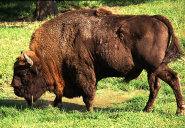 The European Bison (Bison bonasus), also know as "wisent", looks very similar in appearance to its North American cousin, the Bison bison. It shares some of the same characteristics of its North American relative, such as a pronounced shoulder hump, short neck, and overall body thickness, except the European Bison is smaller in stature. You can tell the difference between them by the European Bison's longer mane of hair on its forehead and underneath the neck. Its coat is also less shaggy than the American Bison and varies in color from golden brown to dark brown. Both males and females have short horns that curve upwards and project outwards.
The European Bison (Bison bonasus), also know as "wisent", looks very similar in appearance to its North American cousin, the Bison bison. It shares some of the same characteristics of its North American relative, such as a pronounced shoulder hump, short neck, and overall body thickness, except the European Bison is smaller in stature. You can tell the difference between them by the European Bison's longer mane of hair on its forehead and underneath the neck. Its coat is also less shaggy than the American Bison and varies in color from golden brown to dark brown. Both males and females have short horns that curve upwards and project outwards.Typically, the European Bison is around 2.9 meters or 9 and 1/2 feet in length and 1.8 to 1.95 meters or 5 feet 10 inches to 6 feet 4 inches tall. It typically weighs anywhere from 800 to 1,000 kg or from 1763 pounds to a little over 2200 pounds. It also features a tail that is typically around 2 and a half feet long.
For many years the European Bison was known to roam throughout the southeastern, central, and western regions of Europe.
The European Bison has been rated as a vulnerable species on the IUCN red list, with an estimated population of around 2000 and growing. Many of these current creatures, however, are not considered mature individuals, meaning they have not reached breeding age yet. Currently, the population size is increasing and due to the low mortality rate of the species some populations have even needed to be culled in order to manage them better.
While these creatures may be found feeding on shoots and leaves, their most common food is grass. They also must drink every day, sometimes using their hooves to break ice so they can drink the water. European Bison are especially agile for their size, being able to clear a stream of up to 3 meters from a standing position. There were times when predators like wolves and bears were a threat to this creature, but the number one predator of European Bison was and always will be man.
Picture of the European bison by Henryk Kotowski, en:User:Kotoviski, licensed under GFDL
Which zoos have them?
Artis (Netherlands)The European bison, wisent is listed as Endangered (EN), considered to be facing a very high risk of extinction in the wild, on the IUCN Red List of Threatened Species
Some facts about the
European bison
Adult weight : 610 kg (1342 lbs)
Maximum longevity : 26 years
Female maturity :730 days
Male maturity : 730 days
Gestation : 270 days
Weaning : 213 days
Litter size : 1
Litters per year : 1
Interval between litters : 641 days
Weight at birth : 23.375 kg (51.425 lbs)

Custom Search